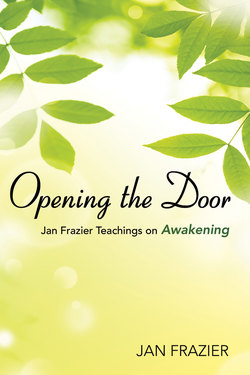Читать книгу Opening the Door: Jan Frazier Teachings On Awakening - Jan Inc. Frazier - Страница 7
На сайте Литреса книга снята с продажи.
Conditioning
ОглавлениеWhen I first was drawn to the spiritual practice I did for many years, one of the things that most appealed about it was the recommended practice of noticing what was going on in my head as I moved through my day. Not like an aggressive gardener bent on rooting out weeds, but gently, curiously. Just observing. Seeing how I reacted, on the inside, to things that happened on the outside. My young children squabbling: how that generated heat in my body, which generated yelling (and sometimes grabbing). My husband calling late in the afternoon to say he’d be delayed getting home: how that made the remaining minutes of being a single parent seem to elongate, multiply. Receiving a real letter from the editor of a literary journal, instead of the usual small rejection slip: how that swelled my heart, gave me a sense of being a real writer.
Until I encountered this idea of noticing my interior as its own world, it hadn’t occurred to me that there was a separation between that reality and the one out there — the things that happened, the situations surrounding me. To me it was all a big integrated blob, the inner and the outer woven together in a way that made them a single thing. A unified reality. As far as I had always understood it, there was a causal, inevitable relationship between what happened and how it affected me. As my mother often used to say of her own behavior and attitudes, I couldn’t help it.
When I was growing up, I hated that she would say that, especially when it had to do with things about herself that I saw as signs of bigotry. The colored laborer working in the lot beside our white-neighborhood house, in the early 1960s, who asked for a drink of water and was handed a peanut butter jar to drink out of. I chided her for that. When she said she couldn’t help it, she really meant that. She truly couldn’t help thinking the man had cooties, and that ever after, our drinking glass would not be able to be sufficiently cleaned. She thought she couldn’t help her feelings, and so truly — in some sense — she could not.
I might have prided myself on being free of my mother’s egregious bigotry. But the truth was, all my life, until I stumbled onto the idea that my inner world was distinct from the outer one, I believed as truly as my mother did that I couldn’t help feeling what I felt. You might say I couldn’t help being racially tolerant. Because of my conditioning — because of growing up in the mind-opening sixties, because of attending a racially integrated school — I couldn’t help recognizing that people were people. My mother had her conditioning. If I had grown up in the 1930s, in a world where the races were sharply divided by a set of unquestioned assumptions, probably I would have really believed the black man’s mouth was unclean in a way my own was not.
The deep value of observing the inner world is to see that it is, by its very nature, a conditioned place (the particulars of the conditioning being not so relevant). As a mother, I had conditioned myself to believe my little children should never squabble. Oh, I never had this thought consciously. But the fact that I reacted to their uproars with such frustration, such heat, had behind it the thought that there was something “wrong” with them getting into struggles with one another. Along with that thought came the unwillingness to accept the reality of the tearful commotions. I didn’t want them to squabble. I wanted them to always get along. It would make my life easier. Even if I could have just looked at that, at what I wanted — for them to never fight, never cry, never need my intervention — a breath of calming air could have entered the moment. But until this practice of honestly looking at what went on in my interior, it simply never occurred to me that the source of my frustration — of my pretty regular suffering as a mother — was not my children’s behavior. It was what went on in my head. Once I began to look, the inner world and the outer world started to appear to be separate things, carrying on quite independently. They were not, as I had believed my entire life prior, a single thing. Before, I had thought the only way for me to feel better inside would be to control what was happening on the outside: to somehow cause my children to get along all day. (Lotsa luck on that one.)
I couldn’t change my conditioning; I couldn’t make my thoughts go away. But if I could see them for what they were, if I could see that they were products of my history, of my own interior, I might not have to live at the mercy of them. If I could realize that my inner world was its own thing, not actually caused by what was happening, I might be able to just be present with my children — even if what the present held was squabbling. I might be able to accept what was actually happening, without experiencing it through the limiting blinders of how I wanted things to be. I might be able to imagine my children’s own frustration and confusion, to be a real help to them.
And who knows? If my mother could have seen she was the product of her history, her conditioning, might she have been able to be truly present with that thirsty man? Unburdened of ideas, might she have been able to simply imagine his dry mouth, get him a glass of water?
